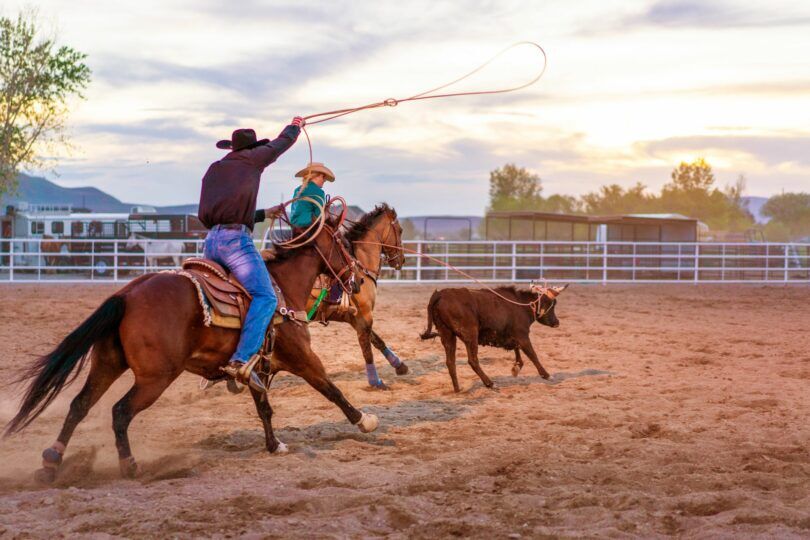Heading and Heeling Explained
If you’ve ever been to a rodeo, chances are you’ve had the opportunity to watch the team roping event. This exciting sport is a beautiful example of how horse and rider can come together to work a specific task.
The heel horse is a member of the dynamic duo that makes up a roping team. They are responsible for roping the hind legs of the steer. These horses need to be strong and athletic as they compete against the clock and the speed of the steer.
The first horse my family ever owned was a retired heel horse. He was hard working and sturdy, and boy oh boy, could he be stubborn!
Team Roping: An Overview
Team roping originated from working cattle ranches where the task of bringing in larger steers was challenging for just one person. Ranchers found that roping the front end and hind end of the steers made it much easier for them to capture the steer and complete their tasks.
This roping team is made up of two skilled ropers. They are called the “header” and the “heeler.”
Both horses start out in the boxes on either side of the chute that holds the steer. Once the steer is released, the header and the heeler sprint out to rope their specific body parts. The fastest team that ropes the steer with legal catches, wins.
What are legal catches? For the header, the rope can only be around slick horns, half the head, or around the neck. For the heeler, the rope must be around both hind legs. Single leg catches will result in a time penalty.
What is harder, heading or heeling?
Comparisons like these are always difficult to speak to since the difficulty will also depend on the skill one has as a roper and the natural abilities of the horse.
As with any sport, many times preference takes precedence over which role is more difficult.
Being a header or a heeler both require roping a moving target, which I say sounds quite difficult!
How many hands tall is a typical roping horse?
Most roping horses are stock breeds. Because of this, they run on the smaller side, somewhere between 14.2 and 15.1 hands.
Can there be taller, 16 hand roping horses? Absolutely! The smaller horses are just more common.
Photo Cred: Canva
The Head Horse
As mentioned earlier, the head horse is responsible for roping the head of the steer. Although it seems simple, there’s a bit more to it.
What does the head horse do?
Once the head horse breaks from the box and the roper catches the head of the steer, the head horse typically tracks left and pulls the steer to allow for the heeler to do their job.
Once the heeler has captured the hind legs, the head horse will then stop and face the steer and the heeler.
The Heel Horse
The heel horse is a very important part of the roping team as they essentially stop the steer from moving forward any further.
How do you teach a horse to heel?
Most ropers begin teaching their horses how to heel by using a steer dummy. This allows the horse to learn to track the steer without the unpredictability of a live animal.
The rope is introduced once the horse is comfortable finding and following the dummy. It’s only after all these steps is the live cow brought in!
How tall should a heel horse be?
Horses that have a smaller stature and shorter stride are usually preferred over large strided horses.
The sweet spot tends to be around 14.3 hands to 15.2 hands.
Photo Cred: Canva
Similarities and Differences
Although the head horse and the heel horse are roping a steer, there are some similarities and differences between them.
Similarities between a Head Horse and a Heel Horse:
- Head and heel horses will have smaller, stocky builds
- Both learn to track a cow
- Both must possess speed and athletic ability
Differences between a Head Horse and a Heel Horse:
- Head horses need to be stout enough to take a jerk from the steer
- Head horses turn and face the steer
- The heel horse will tension the rope once caught
Frequently Asked Questions
Q: What is a head horse?
This is the horse and rider that is responsible for roping the steer’s head.
Q: How do you throw a perfect heel loop?
When learning to rope, there are typically two different techniques to throwing the perfect heel loop. The first being “roping” or “scooping,” and the second technique being “the trap.”
Regardless of which technique you learn first, the biggest advice is to practice!
Q: What should you look for in a heel horse?
Due to the nature of the event, a heavily muscled stock horse that has athletic talent to burst out of the box and dig in to stop is preferred.
Parting Thoughts
The sport of team roping is a true showcase of horsemanship and teamwork. If you haven’t had the opportunity to witness the “headers” and “heelers” in action, I urge you to check it out when you get a chance!
P.S. Enjoy this article? Trot on over to:
- 5 Comfy Tall Riding Boots That Look as Good as They Feel
- 3 Best
Dressage Boots for Horses Moving Up the Levels - 4 Dressage Fashion Trends & Salute-Worthy Styles
- Matt Harnacke Inside Scoop (Dressage, Horses, Fan Quiz)
- Matt Harnacke
Dressage Equestrian Vlog
